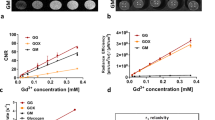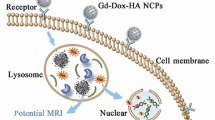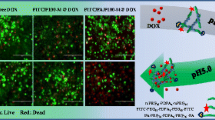Abstract
The effective drug delivery systems for cancer treatment are currently on high demand. In this paper, biological behavior of the novel hybrid copolymers based on polysaccharide glycogen were characterized. The copolymers were modified by fluorescent dyes for flow cytometry, confocal microscopy, and in vivo fluorescence imaging. Moreover, the effect of oxazoline grafts on degradation rate was examined. Intracellular localization, cytotoxicity, and internalization route of the modified copolymers were examined on HepG2 cell line. Biodistribution of copolymers was addressed by in vivo fluorescence imaging in C57BL/6 mice. Our results indicate biocompatibility, biodegradability, and non-toxicity of the glycogen-based hybrid copolymers. Copolymers were endocyted into the cytoplasm, most probably via caveolae-mediated endocytosis. Higher content of oxazoline in polymers slowed down cellular uptake. No strong colocalization of the glycogen-based probe with lysosomes was observed; thus, it seems that the modified externally administered glycogen is degraded in the same way as an endogenous glycogen. In vivo experiment showed relatively fast biodistribution and biodegradation. In conclusion, this novel nanoprobe offers unique chemical and biological attributes for its use as a novel drug delivery system that might serve as an efficient carrier for cancer therapeutics with multimodal imaging properties.






Similar content being viewed by others

Abbreviations
- 7-AAD:
-
7-aminoactinomycin D
- DMSO:
-
dimethyl sulfoxide
- DOTA:
-
1,4,7,10-tetraazacyclododecane-1,4,7,10-tetraacetic acid
- EPR:
-
enhanced permeability and retention
- ESI-MS:
-
electrospray ionization mass spectrometry
- FITC:
-
fluorescein isothiocyanate
- GG:
-
glycogen
- HBSS:
-
Hanks’ Balanced Salt Solution
- LGS:
-
liver glycogen synthase
- MBCD:
-
methyl-β-cyclodextrin
- MEM:
-
Minimum Essential Medium
- MRI:
-
magnetic resonance imaging
- NHS ester:
-
N-hydroxysuccinimide ester
- ROI:
-
region of interest
References
Cho K, Wang X, Nie S, Chen ZG, Shin DM. Therapeutic nanoparticles for drug delivery in cancer. Clin Cancer Res Off J Am Assoc Cancer Res. 2008;14:1310–6.
Fang J, Nakamura H, Maeda H. The EPR effect: unique features of tumor blood vessels for drug delivery, factors involved, and limitations and augmentation of the effect. Adv Drug Deliv Rev. 2011;63:136–51.
Taurin S, Nehoff H, Greish K. Anticancer nanomedicine and tumor vascular permeability; where is the missing link? J Control Release Off J Control Release Soc. 2012;164:265–75.
Talelli M, Iman M, Rijcken CJF, van Nostrum CF, Hennink WE. Targeted core-crosslinked polymeric micelles with controlled release of covalently entrapped doxorubicin. J Control Release 2010;148:e121–e122.
Barar J, Omidi Y. Dysregulated pH in tumor microenvironment checkmates cancer therapy. BioImpacts BI. 2013;3:149–62.
Omidi Y, Barar J. Targeting tumor microenvironment: crossing tumor interstitial fluid by multifunctional nanomedicines. BioImpacts BI. 2014;4:55–67.
Tirone TA, Brunicardi FC. Overview of glucose regulation. World J Surg. 2001;25:461–7.
Filippov SK, Sedlacek O, Bogomolova A, Vetrik M, Jirak D, Kovar J, et al. Glycogen as a biodegradable construction nanomaterial for in vivo use. Macromol Biosci. 2012;12:1731–8.
Cabral H, Matsumoto Y, Mizuno K, Chen Q, Murakami M, Kimura M, et al. Accumulation of sub-100 nm polymeric micelles in poorly permeable tumours depends on size. Nat Nanotechnol. 2011;6:815–23.
Rybicka KK. Glycosomes—the organelles of glycogen metabolism. Tissue Cell. 1996;28:253–65.
Izawa H, Nawaji M, Kaneko Y, Kadokawa J. Preparation of glycogen-based polysaccharide materials by phosphorylase-catalyzed chain elongation of glycogen. Macromol Biosci. 2009;9:1098–104.
Duncan R, Gilbert HRP, Carbajo RJ, Vicent MJ. Polymer masked−unmasked protein therapy. 1. Bioresponsive dextrin−trypsin and −melanocyte stimulating hormone conjugates designed for α-amylase activation. Biomacromolecules. 2008;9:1146–54.
Hreczuk-Hirst D, Chicco D, German L, Duncan R. Dextrins as potential carriers for drug targeting: tailored rates of dextrin degradation by introduction of pendant groups. Int J Pharm. 2001;230:57–66.
Pospisilova A, Filippov SK, Bogomolova A, Turner S, Sedlacek O, Matushkin N, et al. Glycogen-graft-poly(2-alkyl-2-oxazolines)—the new versatile biopolymer-based thermoresponsive macromolecular toolbox. RSC Adv. 2014;4:61580–8.
Aleksandrova LA, Kutuzova TM, Kraevskii AA, Kukhanova MK, Gottikh BP. Aminoacyl derivatives of nucleosides, nucleotides, and polynucleotides. Bull Acad Sci USSR Div Chem Sci. 1977;26:583–9.
Chen RF. Dansyl labeled proteins: determination of extinction coefficient and number of bound residues with radioactive dansyl chloride. Anal Biochem. 1968;25:412–6.
Hoechst Stains [Internet]. 2015. Available from: https://tools.thermofisher.com/content/sfs/manuals/mp21486.pdf
LysoTracker® and LysoSensor™ Probes [Internet]. 2015. Available from: https://tools.thermofisher.com/content/sfs/manuals/mp07525.pdf
Freshney RI. Culture of animal cells: a manual of basic technique. Wiley; 2000.
Lloyd JB, Mason RW, editors. Biology of the lysosome [Internet]. Boston, MA: Springer US; 1996 [cited 2015 Dec 4]. Available from: http://link.springer.com/10.1007/978-1-4615-5833-0
Fernández-Novell JM, Bellido D, Vilaró S, Guinovart JJ. Glucose induces the translocation of glycogen synthase to the cell cortex in rat hepatocytes. Biochem J. 1997;321:227–31.
García-Rocha M, Roca A, De La Iglesia N, Baba O, Fernández-Novell JM, Ferrer JC, et al. Intracellular distribution of glycogen synthase and glycogen in primary cultured rat hepatocytes. Biochem J. 2001;357:17–24.
Ros S, García-Rocha M, Domínguez J, Ferrer JC, Guinovart JJ. Control of liver glycogen synthase activity and intracellular distribution by phosphorylation. J Biol Chem. 2009;284:6370–8.
Fernández-Novell JM, López-Iglesias C, Ferrer JC, Guinovart JJ. Zonal distribution of glycogen synthesis in isolated rat hepatocytes. FEBS Lett. 2002;531:222–8.
Rewatkar PV, Parton RG, Parekh HS, Parat M-O. Are caveolae a cellular entry route for non-viral therapeutic delivery systems? Adv Drug Deliv Rev. 2015;91:92–108.
Oh N, Park J-H. Endocytosis and exocytosis of nanoparticles in mammalian cells. Int J Nanomedicine. 2014;9:51–63.
Chang Y, Lee GH, Kim T-J, Chae K-S. Toxicity of magnetic resonance imaging agents: small molecule and nanoparticle. Curr Top Med Chem. 2013;13:434–45.
Zhou Z, Lu Z-R. Gadolinium-based contrast agents for magnetic resonance cancer imaging. Wiley Interdiscip Rev Nanomed Nanobiotechnol. 2013;5:1–18.
Lansman JB. Blockade of current through single calcium channels by trivalent lanthanide cations. Effect of ionic radius on the rates of ion entry and exit. J Gen Physiol. 1990;95:679–96.
Biagi BA, Enyeart JJ. Gadolinium blocks low- and high-threshold calcium currents in pituitary cells. Am J Physiol - Cell Physiol. 1990;259:C515–20.
Acknowledgements
This work was supported by the Grant Agency of the Ministry of Health, Czech Republic [grant number 15-25781a], the Czech Science Foundation [grant number 13-08336S], the Charles University in Prague (Faculty of Science), and project GA UK [grant number 282216], and the confocal microscopy part (M. Pařízek) was supported by the Czech Science Foundation [grant number P108/12/1168]. We would like to thank Alena Sekerková for help with flow cytometry measurements.
Author information
Authors and Affiliations
Corresponding author
Ethics declarations
All protocols were approved by the Ethical Committee of the Institute for Clinical and Experimental Medicine and the experiments were carried out in accordance with the European Communities Council Directive (86/609/EEC). All institutional and national guidelines for the care and use of laboratory animals were followed.
Conflict of interest
The authors declare that they have no conflict of interest.
Electronic supplementary material
ESM 1
(DOCX 226 kb)
Rights and permissions
About this article
Cite this article
Jirátová, M., Pospíšilová, A., Rabyk, M. et al. Biological characterization of a novel hybrid copolymer carrier system based on glycogen. Drug Deliv. and Transl. Res. 8, 73–82 (2018). https://doi.org/10.1007/s13346-017-0436-x
Published:
Issue Date:
DOI: https://doi.org/10.1007/s13346-017-0436-x



